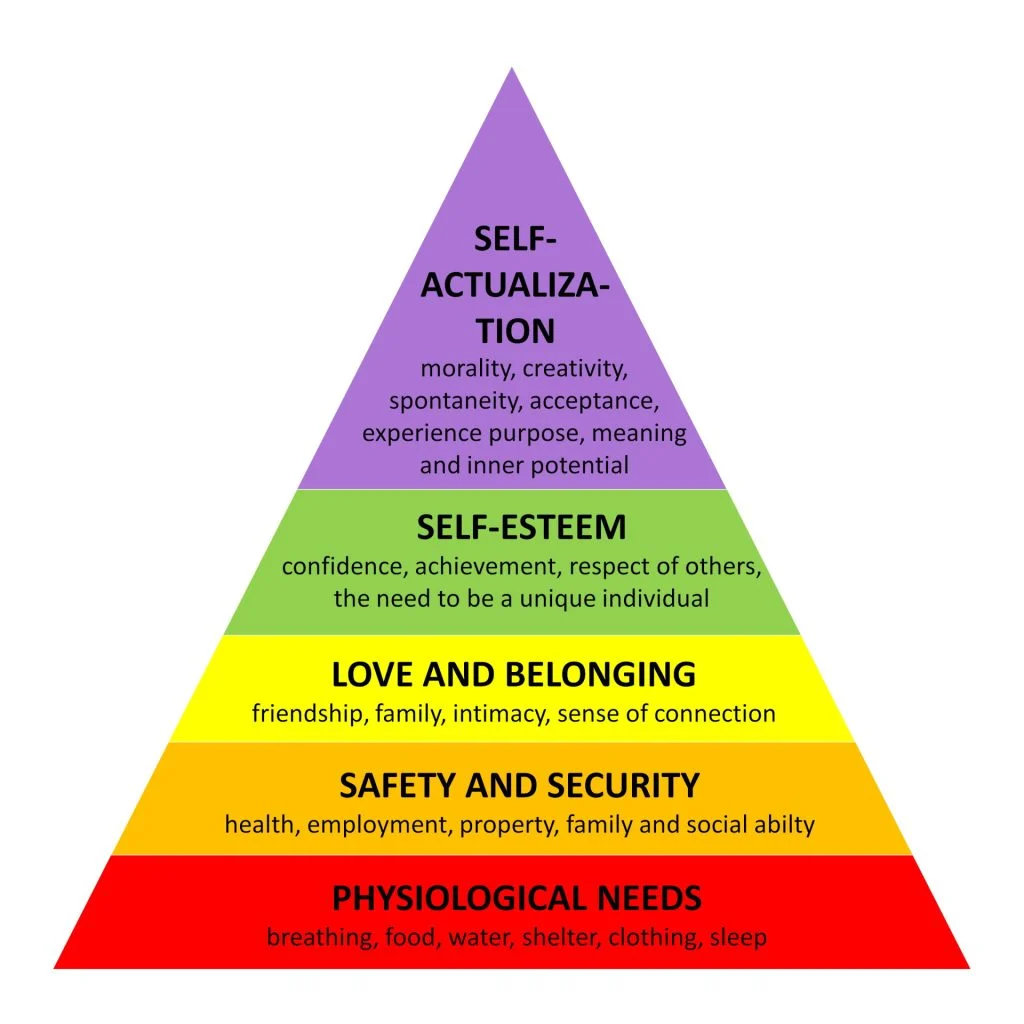
Introduced in his 1943 paper "A Theory of Human Motivation" and expanded in his book "Motivation and Personality," Maslow's hierarchy is depicted as a pyramid with five core levels.
Physiological Needs
These are the most fundamental needs required for human survival:
- Food and Water: Essential for energy and bodily functions.
- Breathing: The basic necessity for sustaining life.
- Shelter: Protection from environmental elements and a safe place to live.
- Clothing: Necessary for warmth and protection.
- Sleep: Vital for physical and mental health.
- Reproduction: Ensuring the continuation of the species.
Without these basic needs being met, the human body cannot function optimally, and higher-level needs become secondary.
Safety Needs
Once physiological needs are satisfied, the focus shifts to safety and security:
- Personal Security: Protection from physical harm and danger.
- Financial Security: Stable income and financial resources to avoid economic stress.
- Health and Well-being: Access to medical care and maintaining good health.
- Property: Owning property and a stable living environment.
- Safety Net: Assurance of social and financial support during times of crisis.
Meeting safety needs ensures that individuals can feel secure and protected in their environment.
Love and Belonging Needs
Social relationships become a priority after safety needs are addressed:
- Friendship: Developing social connections and companionship.
- Intimacy: Forming romantic relationships and emotional bonds.
- Family: Maintaining strong family ties and a sense of belonging.
- Community: Participating in social and community groups.
Fulfilling love and belonging needs contributes to emotional well-being and helps individuals feel connected to others.
Esteem Needs
Esteem needs encompass the desire for respect, recognition, and self-worth:
- Self-Esteem: A personal sense of achievement, confidence, and independence.
- Status: Recognition and respect from others within a social context.
- Prestige: Attaining a respected position and reputation in society.
- Accomplishment: Achieving personal and professional goals and ambitions.
Esteem needs, when satisfied, foster feelings of self-confidence and value, both from oneself and from others.
Self-Actualisation Needs
At the pinnacle of Maslow's hierarchy is self-actualization, the realization of one's potential:
- Personal Growth: Ongoing self-improvement and development.
- Creativity: Engaging in creative pursuits and innovative activities.
- Spontaneity Embracing authenticity and spontaneity in life.
- Purpose: Finding and fulfilling a meaningful purpose in life.
- Inner Potential: Striving to achieve one's full potential and capabilities.
Self-actualization represents the desire to become the most complete and authentic version of oneself.
Expanded Hierarchy
Maslow later expanded his model to include additional levels beyond self-actualisation:
Cognitive Needs
- Knowledge: The pursuit of intellectual growth and understanding.
- Curiosity: A natural drive to explore, learn, and satisfy intellectual curiosity.
- Exploration: Engaging in activities that expand one's knowledge and understanding of the world.
Aesthetic Needs
- Beauty: An appreciation for beauty in art, nature, and life.
- Balance and Form: A desire for harmony, order, and balance in one’s environment.
Transcendence Needs
- Helping Others: The drive to assist others in achieving their potential.
- Spirituality: Connecting with something greater than oneself, often through spiritual or religious experiences.
Applications of Maslow's Theory
Maslow's Hierarchy of Needs has practical applications across various fields, including:
- Psychology: Understanding human motivation and behavior.
- Education: Addressing students' basic needs to foster an effective learning environment.
- Business: Guiding employee motivation, workplace design, and leadership strategies to enhance productivity and satisfaction.
Additionally, Maslow's theory is instrumental in goal-setting. It suggests that individuals are unlikely to pursue higher-level goals related to self-actualization if their basic needs, such as safety and belonging, are not met. For instance, a person struggling with financial insecurity (a safety need) will find it challenging to focus on personal growth or achieving their full potential. By recognising this hierarchy, individuals and organisations can prioritise needs effectively to support holistic development and goal achievement.
Criticisms and Limitations
Maslow's hierarchy has faced criticism for its lack of empirical support and its rigid structure. Critics argue that human needs do not always follow a strict hierarchical order and that cultural and individual differences significantly impact how needs are prioritised. Furthermore, the theory does not fully account for the complexity of human motivation, where different needs might overlap and influence each other simultaneously.
Modern Perspectives
Modern psychologists have built upon Maslow's work, integrating aspects of positive psychology, which focuses on human strengths and flourishing. Notable contributors include:
- Martin Seligman: Known as the father of positive psychology, Seligman has focused on the study of happiness and well-being, introducing concepts like PERMA (Positive Emotion, Engagement, Relationships, Meaning, Accomplishment).
- Mihaly Csikszentmihalyi: Renowned for his work on the concept of "flow," a state of deep immersion and engagement in activities.
- Carol Dweck: Her research on mindset, particularly the distinction between fixed and growth mindsets, has influenced educational and developmental psychology.
The concept of self-actualization has also evolved to emphasise the fluid and dynamic nature of personal growth and fulfillment. Current research often explores how individuals can achieve well-being and thrive in diverse and changing environments.
